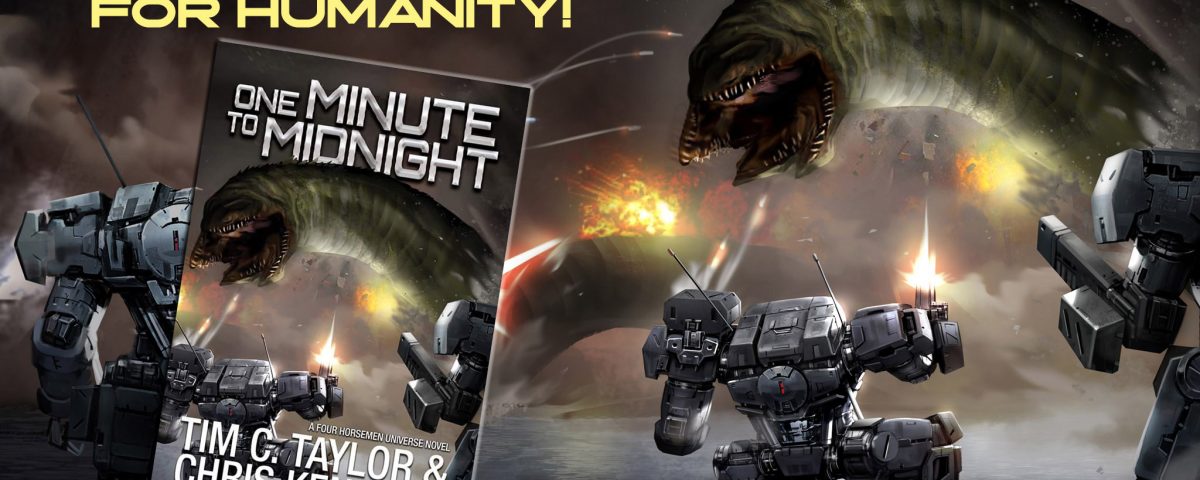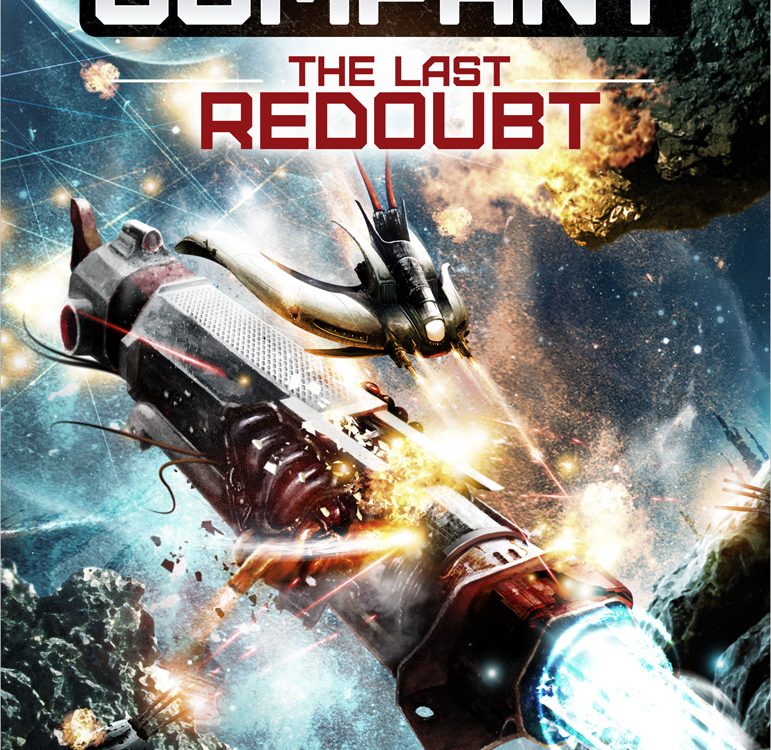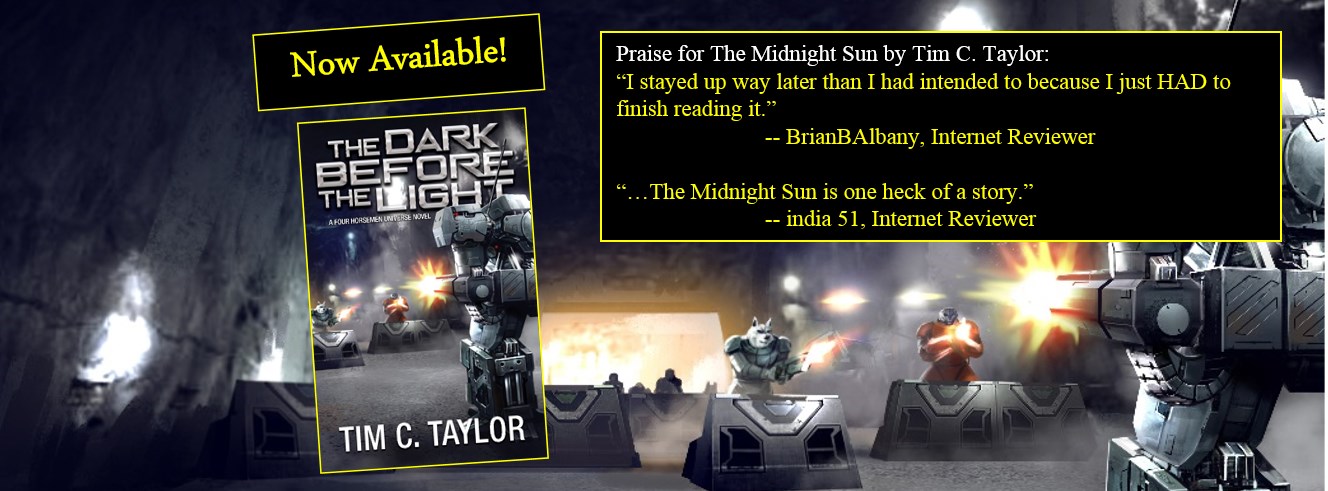
The Dark Before the Light – out today.
June 19, 2020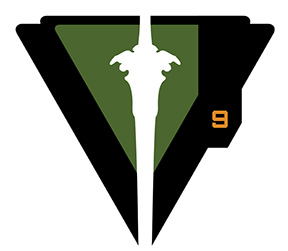
I’ve taken most of Chimera Company off sale
September 30, 2020One Minute to Midnight is out now. This is the conclusion to the trio of 2020 Four Horsemen Universe (4HU) novels that kicked off with Endless Night and carried through The Dark Before the Light.
When I say conclusion, it’s certainly that. Everything I’ve written in 4HU leads to this point. After three years, six stories, and about half a million words, I hope you’ll forgive me if I choke back a tear as I say goodbye…
(… and then immediately start thinking about what happens next. Can’t help it. Maybe some of my ‘Midnight Sun’ characters will carry over to whatever follows? I hope to write more in this universe before too long.)
Here are the links for anyone wanting to wade straight into the book.
amazon.com | amazon.co.uk | amazon.com.au | amazon.ca | amazon.it (Hello to my Italian readers 🙂 )
If you haven’t started reading this series yet, One Minute isn’t a great place to start. A better place is the start of the trilogy, Endless Night, or even before that with The Midnight Sun. I wrote both of those books as potential starting points for new readers.
Or you could start at Endless Night to read the 2020 trilogy and then go back to The Midnight Sun if you like it.
There are many routes through the 4HU books and one of the simplest is to start at the very beginning with Cartwright’s Cavaliers by Mark Wandrey.
For more info on 4HU, I’ve written a guide here.
I should say that One Minute to Midnight is out on Kindle and paperback editions, but not yet on audio.
If you like your audio, the first book in the trilogy, Endless Night came out last week, published by Podium. The Dark Before the Light is about to start production and One Minute to Midnight will follow soon.

Combined Arms
If you look at the cover of One Minute to Midnight, you’ll see something unusual for one of my novels, the names of other authors.
The name I wasn’t expecting to see there was Chuck Gannon. Now, Charles E Gannon’s a very successful and highly popular author who’s been nominated several times for the Nebula award for best novel, including this year. So that’s prestigious company. But his is a bonus story that, if I remember rightly, arrived too late or perhaps too big for a recent anthology. I only read it on release day, and I have to say… wow! 😊
The other the name is Chris Kennedy. We co-wrote this novel.
I was nervous about how this would work out. The fact it was a pleasure makes me want to co-write more in the future.
Here’s a few insights into how we handled collaborative working, including a few details that might surprise 4HU readers. Hopefully there are some lessons to take away for anyone considering co-writing in the future, most importantly… me. So I can remember what to do next time!
One Minute to Midnight caps a trilogy of novels that started with Endless Night. More than that, it’s the climax to all six of my previous 4HU stories. So even though Chris knew a lot more about where the wider 4HU was headed, this little part of the universe had been my playground and I wanted it to be a climax to some of the ideas I’d been developing across those previous six stories.
So I kicked off by writing a summary of where we were, locations and characters, some of the things I wanted to do at the end of the book.
Having written down where we were, and where I wanted us to be, I then added some ideas of how we would get from one to the other.
We talked through all this on a video chat for an hour. (We had a couple more video chats later in the project when we needed to thrash out next moves). We didn’t nail everything down in that first chat, but we had a bunch of ideas and we did know how the opening steps would play out.
So we divvied up blocks of writing tasks and set to work.

How to write at differing rates
Chris is a faster writer than me, (at least at the moment — I’m working on speeding things up 😊 ), but he has hugely more commitments. He was also co-writing a book called Gale Force with Mark Wandrey at the time, for example. For the first couple of weeks or so, I think I was laying down more words in Chris, but that didn’t matter because we knew how our sections would interact, and there were some placeholder scenes that were outlined.
Both of us ended up writing placeholder sections that told both ourselves and our partner the key details of what would happen so we could both move on and write scenes later in the story.
We did this for a number of reasons. In some cases, we were working at different speeds and we needed to agree how our sections would interact so the one making faster progress wasn’t stymied. In one case I wrote an outline of what would happen in a big space battle sequence. Chris would write the immediate aftermath of the space battle. Meanwhile, I wrote about a recon mission happening in parallel in another star system. I chose to write in that sequence because I knew how the space battle would turn out (or so I initially thought), but I was much shakier with the recon chapters. It was a case of me needing to figure out that part of the story by writing it.
Chris read and reviewed my placeholder scenes as I wrote them and, in this case, he made some crucial comments on a part of the space battle that didn’t ring true to him. This improved it without doubt. He couldn’t have done that if I hadn’t provided enough detail for him to get his teeth into. The same was true the other way around: I would ask questions of any placeholders until it made sense to me and told me what I need to do to interface with it.
Interface.
Does that sound a bit technical to you? Software tech?
Well, it should do.
I learned my coding architecture at university in the 1980s, using a language developed in the 70s called MODULA-2. It was the first major language to develop the idea of separating the public interface of a software unit from its implementation. In other words, so long as we agree what a software object needs to do and how it interacts with the rest of the software, we can come back and design the detail later. And we can improve the implentation as much as we like, so long we don’t change the interface (or break the code).
In other words, exactly what Chris and I were doing with our co-writing.
Over the past decade as a professional author, I’ve found endless similarities with my previous two decades in the software industry, whether it’s co-working, project planning, the need for blue sky thinking, architecture, refactoring, or defect detection. It’s the same combination of art, engineering, ingenuity and learned craft technique. I’ve found the shift from coding software to crafting stories more of a career sidestep than a leap.
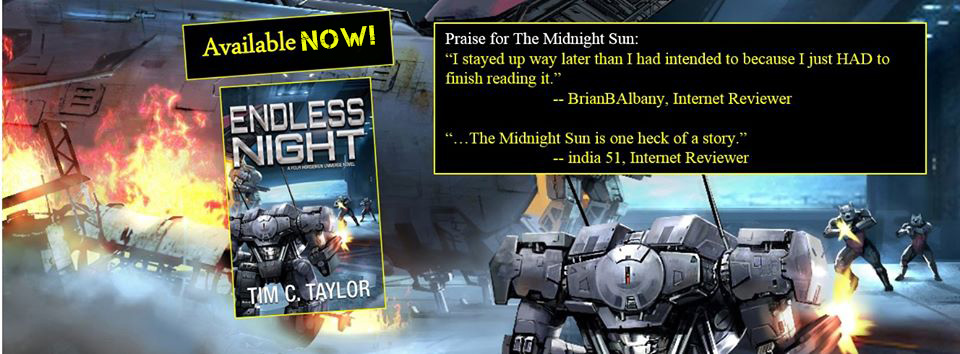
You show me yours…
Back to the co-writing. One of the crucial things Chris took from his previous co-writing experience was the discipline of starting the day with reading what I’d written the day before, making comment suggestions and edits as appropriate. He always did this, even when busy with other calls on his time.
Reviewing each other’s work had been the plan with my previous experience of co-writing, but that hadn’t played out due to a crucial difference: with One Minute to Midnight, Chris and I were both committed to this project throughout.
I think this gave us several benefits.
If you see what the other person’s written every day, and do so first thing, it does make you feel like you really are part of a team.
We also saw opportunities to thread our various segments together. It could be simple, such as vehicle taking damage in a scene that Chris had written. If I were writing something that happened later in the timeline, I might make a casual reference to that damage. Or better still, it might become an important plot point.
There’s another reason too. Chris and I are both relatively ego free, in the sense that we wanted to tell the best story in the best way that we could. Did the final description of that character came from me or Chris? How about that line of dialogue? I don’t know. It didn’t matter.
Although we divided up the novel into around half a dozen sections each of us wrote the initial draft for, we each made changes to the other’s text.
First passes can be a little clumsy at times. I usually iterate through several readthroughs, each time taking the clunkier paragraphs and making them better. That works so much more effectively when somebody else with a different ear is making the text sound right to them.
That’s especially true where we wrote for characters developed by the other. It also helps to avoid the reader getting a wrench when they move from a chapter written by one author to a chapter written by the other. To some extent, our voices blended.
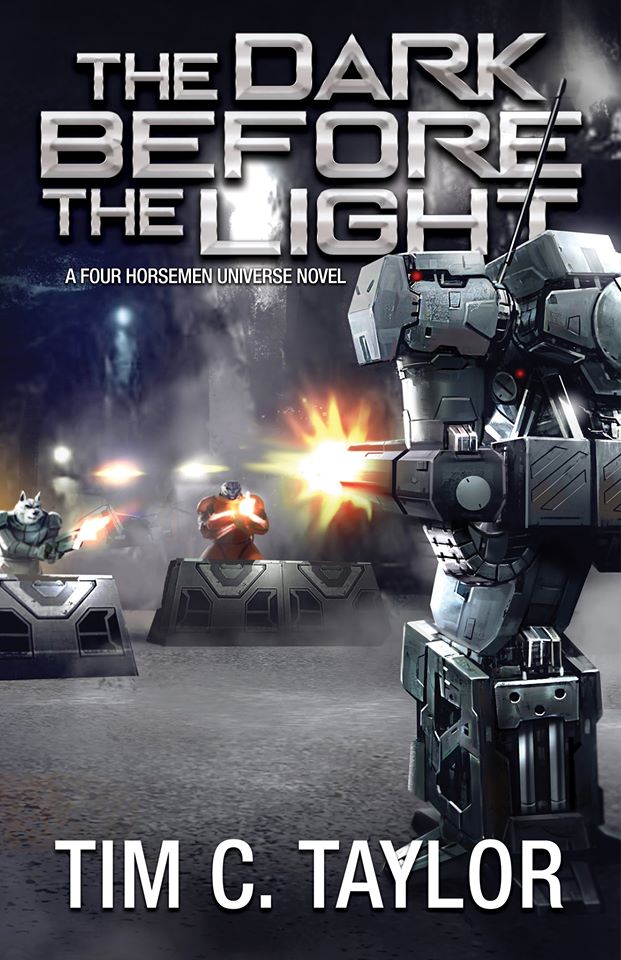
Playing with the Horsemen
One the pleasures for me was to write scenes featuring the mercenary company Chris had developed right from the beginning of the Four Horsemen books. I’m not saying which one because… spoilers… but it was a special thrill and I think Chris is very generous.
Since our various sets of characters, both good and villainous, were joining up for combined operations, it made more sense for us to write both sets of characters, although we wrote the segments where ‘our’ characters were more prominent.
I also got write one of Chris’s latest characters, Beowulf, who was a lot of fun.

Takeaways for Co-writing Writers
I would certainly consider co-writing again. I think it’s difficult to know how well you will work with a specific author until you try it out for real and see whether the chemistry works. That said, there are some things you can do that make collaboration much more likely to be successful. Here’s a few ideas I’d like to carry forward the next time I can write.
You both need to be committed to the project. If one person is more interested than the other, then the project is gonna suck.
Like many other writers, I find the best daily writing discipline for my own projects is to get up early and set to writing first thing. But in co-writing, I think a better discipline is to first read and review what your partner wrote yesterday, especially in our case where our time zones were five hours apart. Making corrections, suggestions, improvements, and typo-fixing each other’s chapters while they’re still wet, will enhance the experience for the readers.
If you write at different rates, and if one partner has a period where they will be off project, then that is a potential source of tension. But if you keep the discipline of checking in with what your partner’s written every day, you can keep the story coherent and backfill your missing parts later.
In my view, if one co-writer puts in significantly more work and delivers more word count than the other then you ought to consider splitting the royalty accordingly. There are great benefits to co-writing, but I’m sure one of the easiest ways to poison team working is for the idea to fester that one of you is freeloading on the back of the other. Better have that conversation sooner rather than later!
So in conclusion, co-writing was a pleasure. And that’s not just me being polite. It was easy and I enjoyed feeling part of a team. And the novel was better and delivered faster than it would have been on my own. What’s not to like?
Plus, I got to write a series of chapters with one of the actual Four Horsemen companies, which was stupendously cool.

Away from 4HU for a moment, I’m busy writing book 4 of Chimera Company. Expect the series to re-launch as novels later this year.
Also, I’ve heard from several people in the last month who have been enjoying the Human Legion audios and are wondering how to get their fix after Renegade Legion. I hear you. I want Human Empire out this year and have been in discussions about how to get the final three novels out to audio faster.
